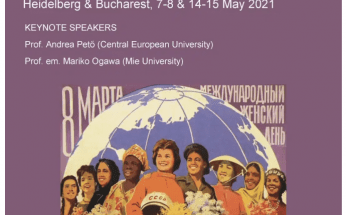Hidden Histories: Women and Science in the Twentieth Century
Virtual conference: 7-8 & 14-15 May 2021
Heidelberg & Bucharest
Co-Organiser: Irina Nastasă-Matei (University of Bucharest)
The virtual conference, co-organised by WEMov WG3 member Irina Nastasă-Matei (with Amelia Bonea) in May 2021 is one of the important scientific events on gender and science of this year. The conference shed light on the professional trajectories of women in various academic fields in the nineteenth and twentieth centuries. Over four full days, fruitful discussions spanned the situation from around Europe and beyond. Among the participants, three other WEMov members contributed as presenters (Marie Ruiz & Camelia Zavarache) and chair (Müge Telci Ozbek).
Marie Ruiz’s paper highlighted the imperial connections between Britain and Canada through the activity of two institutions colonial training school specialised in agriculture. Their education to women migrants was meant to prepare ideal mothers and wives who could assist and help men within a domestic setting. These institutions became international references for training to rural life, while also spreading national health policies and solve the problem of uneducated migrants, as part of a colonial agenda. Towards the end of the period under study (1919-1927), Marie Ruiz observed that in Canada the percentage of the local female students rose.
Back in Europe, but in Romania, another change was taking place. As Camelia Zavarache showed in her paper, the official authorities adapted the legislation to realities on the ground in 1928 by including the obligation that each secondary school have a doctor (female for girls, male for boys). This made it possible for women to engage in school doctor careers, albeit within certain limits. Both papers underlined how women became state collaborators in improving productivity and preparing citizens. A continuation of these endeavours will show how students saw the women teachers/doctors and how women described the relationship they had with their colleagues or their integration in the localities where they went.
Other papers dealt with contemporary periods and higher echelons of education. The socio-political context shaped each of the state responses although the under-representation of women in science in the past remains an undisputed fact. Briefly, some insights. For instance, Daria Bochkova and Katja Doose argued, in URSS there was only an appearance of equality as women remained largely invisible because the state did not promote them beyond the public formal discourse. Even though science might be considered gender neutral, women could be found as technicians, engineers or laboratory assistants, but they hardly reached the leadership positions of directors or managers. Thus, women were still ‘assistants’ and subordinates to men even after two world wars and after they gained the right to vote. In Ireland the examples given by Judith Hartford show that there were women who pushed the limits to succeed even if the odds were against them (strict censorship in culture, refusal to legalise divorce, etc.) Strategies of ‘academic infiltration’, collaborations and partnerships became central to allow women to develop careers and affirm themselves.
Review by Nicoleta Roman (WG3 leader)
